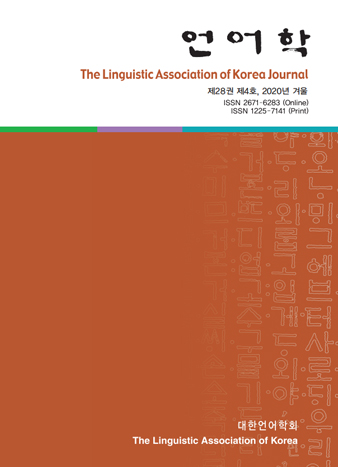대한언어학회 전자저널

28권 4호 (2020년 12월)
- An Aspect of NC Cluster Realizations in Bukusu
-
Chin-Wan Chung
Pages : 121-145
Abstract
Chung, Chin-Wan. (2020). An aspect of NC cluster realizations in Bukusu. The Linguistic Association of Korea Journal, 28(4), 121-145. This study observes various realizations of a nasal plus a consonant (NC) sequence in Bukusu. The newly created Bukusu NCs are composed of a prefix nasal plus a stem-initial consonant, and they are required to have the identical laryngeal, continuant, and place features. If any NCs do not meet these requirements, several sound modifications occur to render NC harmonious with the NC structural requirements. If a post-nasal consonant is a voiceless obstruent, progressive voicing assimilation occurs and then a post-nasal consonant triggers regressive place assimilation. Hardening occurs when a post-nasal consonant has [+voice, +cont]. Post-nasal /l, r, β/ optionally merge with the preceding nasal after becoming hardened and triggering regressive place assimilation if they are followed by a nasal or an NC-initial syllable in a stem. A nasal prefix is deleted if a stem begins with a nasal or a voiceless-initial fricative. Even though different sound change strategies are used in Bukusu, their goal is to make an NC satisfy the requirements of the cluster. In order to provide an analysis, we adopt a constraint-based theoretical framework which allows steps before reaching the final optimal form. This is because some of the sound modifications should occur sequentially. The constraints and their rankings used in the analysis can capture the functional unity that is hidden in sound modification strategies.
Keywords
# nasal plus consonant sequences # constraints # ranking # hardening # assimilation # deletion
References
- Chomsky, N., & Halle, M. (1968). The sound pattern of English. New York: Harper and Row.
- Chung, C.-W. (2009). An asymmetrical realization of nasal-obstruent clusters in English. English Language & Literature Teaching, 15(2), 51-70.
- Chung, C.-W. (2015). An aspect of Pali assimilation. The Linguistic Association of Korea Journal, 23(1), 1-22.
- Clements, G. N. (1986). Compensatory lengthening and consonant gemination in Luganda. In L. Wetzels & E. Sezer (Eds.), Studies in compensatory lengthening (pp. 36-77). Dordrecht: Foris.
- Clements, G. N., & Keyser, S. J. (1983). CV phonology: A generative theory of the syllable. Cambridge, MA: MIT Press.
- Clements, G. N., & Hume, E. (1995). Internal organization of speech sounds. In J. Goldsmith (Ed.), The handbook of phonological theory (pp. 245-306). Cambridge, MA: Blackwell Publishers.
- Downing, L. (1990a). Problems in Jita tonology. Unpublished doctoral dissertation, University of Illinois at Urbana-Champaign.
- Hayes, B., & Stivers, T. (1995). A phonetic account of postnasal voicing. Unpublished manuscript, University of California at Los Angeles.
- Huffman, M. (1993). Phonetic patterns of nasalization and implications for feature specification. In M. Huffman & P. Krakow (Eds.), Nasals, nasalizations, and the velum (pp. 303-327). San Diego: Academic Press.
- Kager, R. (1999). Optimality theory. Cambridge: Cambridge University Press.
- Kahn, D. (1976). Syllable-based generalizations in English phonology. Unpublished doctoral dissertation, MIT.
- Kreidler, C. W. (1989). The pronunciation in English: A course book in phonology. Cambridge, MA: Blackwell Publishers.
- McCarthy, J. (1979). Formal problems in Semitic phonology and morphology. Unpublished doctoral dissertation, MIT.
- McCarthy, J. (1981). A prosodic theory of non-concatenative morphology. Linguistic Inquiry, 12, 373-418.
- McCarthy, J. (2008). The gradual path to cluster simplification. Phonology, 25, 271-319.
- McCarthy. J. (2010). An introduction to harmonic serialism. Unpublished manuscript, University of Massachusetts at Amherst.
- McCarthy, J. (2011). Perceptually grounded faithfulness in harmonic serialism. Linguistic Inquiry, 42, 171-183.
- McCarthy, J., & Prince, A. (1995). Faithfulness and reduplicative identity. In J. Beckman, L. W. Dickey, & S. Urbancyzk (Eds.), University of Massachusetts Occasional Papers in Linguistics 18 (pp. 249-348). Amherst, MA: GLSA, University of Massachusetts.
- McCarthy, J., & Prince, A. (2004). Faithfulness and identity in prosodic morphology. In J. McCarthy (Ed.), Optimality theory: A reader (pp. 77-98). Malden, MA: Blackwell Publishing.
- Mutonyi, N. (1992). Cs and Vs or moras: The case of Bukusu prosodic structure. The OSU Working Papers in Linguistics, 41, 46-84.
- Mutonyi, N. (2000). Aspects of Bukusu morphology and phonology. Unpublished doctoral dissertation, The Ohio State University.
- Niang, M. O. (1997). Constraints on Pulaar phonology. Lanham, MD: University Press of America.
- Odden, D. (2005). Introducing phonology. Cambridge: Cambridge University Press.
- Park, J.-K. (1997). Minimal word effects with special reference to Swahili. Unpublished doctoral dissertation, Indiana University.
- Pater, J. (1996). *NC̥. In Proceedings of NELS 26, 227-239.
- Pater, J. (1999). Austronesian nasal substitution and other NC̥ effects. In R.
- Kager, H. Van der Hulst, & W. Sonneveld (Eds.), The phonology-morphology interface (pp. 310-343). Cambridge: Cambridge University Press.
- Pater, J. (2004). Austronesian nasal substitution and other NC̥ effects. In J. McCarthy (Ed.), Optimality theory: A reader (pp. 271-289). Malden, MA: Blackwell Publishing.
- Prince, A., & Smolensky, P. (1993). Optimality theory: constraint interaction generative grammar. Unpublished manuscript, Rutgers University and University of Colorado.
- Prince, A., & Smolensky, P. (2004). Optimality theory: Constraint interaction in generative grammar. Malden, MA: Blackwell Publishing.